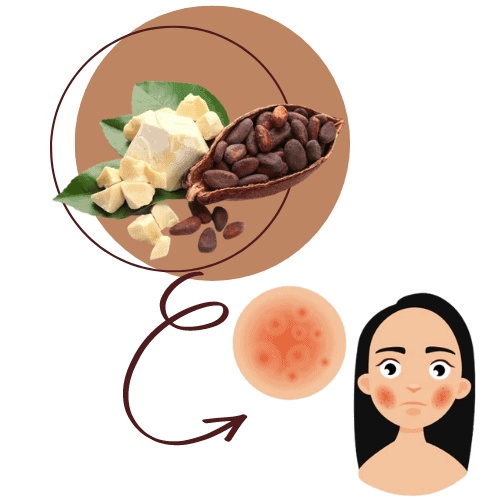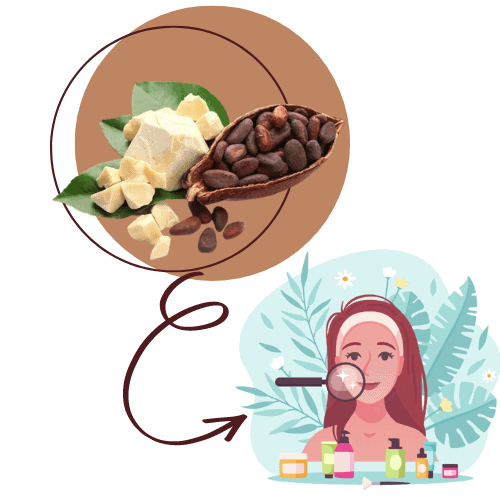Does cocoa butter clog pores? Unfortunately yes! Interestingly not everyone gets their pores clogged from using it. This might sound strange because cocoa butter is known to have a lot of benefits for the skin.
Why does cocoa butter clog pores if it has a lot of benefits for the skin? Why don’t some people experience pore-clogging after using cocoa butter? I’ll explain all that in this post.

Your skin has a lot of tiny openings called pores that release oils and sweat. When dirt and dead skin get trapped in your pores, we say you have clogged pores. It’s mostly the clogged pores that result in acne and breakouts.
Apart from dirt and dead skin cells clogging your pores, the kind of cosmetics and make-up you use on your face could cause your pores to clog. Among those products is cocoa butter. Let’s see what’s in cocoa butter that makes your pores clog.
Facts about cocoa butter clogging pores

There are at least two reasons why cocoa butter clogs pores;
- The molecules in cocoa butter are closely packed. This means that the things or elements that come together to form cocoa butter are stacked tightly closed to each other.
It’s like what makes wood harder than water. Water molecules are loosely packed compared to that of wood, hence wood is harder than water.
The same way cocoa butter is ‘harder’ compared to other moisturizers. This makes it very heavy and therefore covers your pores, making it difficult for dirt and bacteria to escape.
Also, because of its heavy nature, it is sometimes difficult to remove all the particles from your pores. When they accumulate in your pores, you end up with clogged pores.
- Cocoa butter has an essential oil called oleic acid. Oleic acid is an essential oil that your body needs. It is called essential oil, not because you need it in your skin, but because your body can’t produce it by itself.
This oleic acid is what gives cocoa butter its thick and rich feel when melted. You could compare it to the creamer in your coffee. Without it, you won’t have your coffee in that rich amd creamy consistency.
In the same way, oleic acid is serving as the substance that makes cocoa butter-rich and creamy. That’s why it has a high chance of clogging your pores. As a result of these facts, people are spreading one big myth about cocoa butter clogging pores.
The myth about cocoa butter clogging pores
People hold the notion that anyone using cocoa butter would get their pores clogged.
This is false. Rebecca has been using cocoa butter for years now, but she has no signs of clogged pores. (She’s my cousin, by the way).

The reason is simple.
Depending on the kind of skin you have and the type of reaction you’ll have after using cocoa butter. When you have dry skin and don’t break out easily, then cocoa butter won’t clog your pores.
However, if you have oily, acne-prone, and sensitive skin, then you must stay clear of cocoa butter because it would clog your pores and lead to acne.
I’ll explain the process of pore-clogging later in this post.
Okay! So you now know some facts and myths about cocoa butter clogging pores.
It’s time to know what cocoa butter is because knowing what it is would inform the decisions you might be taking in the future regarding skincare products and routines.
Also Read: Top Cocoa Butter Benefits For Skin And Hair: A Comprehensive Guide!
Cocoa Butter as a Skin Product

Cocoa butter is extracted from cocoa beans. Cacao beans are just the name of the seeds from the cacao plant. Don’t get confused. The cacao tree is also known as the cocoa tree. I’d use both terms interchangeably.
It is called cocoa butter because the butter is extracted from the beans of this plant by certain processes.
First, the cocoa beans are fermented for few days and then sun-dried. After the beans are well dried, the farmers would then roast them to develop their ‘nutty’ flavor. The roasting process also makes it easier to remove the hulls, leaving the cocoa nibs behind.
The nibs are then ground into a paste. This paste is pressed by some mechanism to separate the brown solid substance from the cocoa butter. It is from this brown residue that chocolate and cocoa powder are made. It also explains why cocoa butter has a strong smell of chocolate.
But where did this cocoa butter idea come from?
Also Read: Cocoa Butter Benefits for Skin: A Quick Guide!
The origin of cocoa butter
The cacao plant, the plant from which cocoa beans are taken, was first cultivated by the Mayans over 1500 years ago. People from ancient Central and Southern America started planting it too. With time it got to the Caribbeans and other parts of the world.
These days, more than half of the world’s cocoa butter is produced in West African countries like Ghana and Cote d’Ivoire. As it turns out, the cacao plant thrives well in many tropical regions, and therefore, it’s possible to find it in areas apart from the ones mentioned here.
With the cacao plant growing mostly in tropical regions, it is not a surprise that cocoa butter has been attributed to the blacks. Apart from its luxurious and velvety feel on the skin, it has a sweet chocolate scent.
If you love fragrances in your favourite moisturizer, then you’d definitely appreciate cocoa butter.
It also absorbs quickly into the skin and therefore doesn’t make the skin feel greasy. In other words, it makes the skin moisturized without making it look oily. These may be some reasons why people would prefer cocoa butter to other jelly moisturizers like vaseline.
Also Read: What is Cocoa Butter: Benefits, Uses, Characteristics and Side Effects
Does cocoa butter clog pores on the face?
It sure does, depending on the kind of skin you have. If you have dry skin, then cocoa butter would form a protective barrier on the surface of your skin, thereby locking in moisture and keeping your face and skin supple.
However, the case is different when it comes to those with acne-prone, oily, and sensitive skin.
Here’s why.
You see, the skin is already producing oils. These oils are called sebum. Its main function is to lubricate the hair follicles. Those with oily skin produce more oil or sebum than the other skin types.
Your skin is a zoo of all kinds of bacteria. And it’s a good thing because they are not harmful unless they are trapped in your skin. Some of these bacteria feed on the sebum in the pores. When nothing traps them there, they feed and then get out of the pores peacefully.
Using cosmetics on your skin may help to trap the bacteria inside your pores. When they are freely moving about on the skin, there is nothing to worry about. However, when they get trapped, the situation becomes different.
The more your skin produces sebum, or better still the oils, the more these trapped bacteria feed on it. As they feed, they multiply. And the more they multiply, the larger that pore would be.
The swelling and enlargement of the pore are what cause that nice red breakout on your face. Those with normal to dry skin have a minimal breakout from using cocoa butter.
Why?
Because the skin is not producing a lot of oil already, hence the bacteria won’t be so interested in hiding in the pores. Even if they did hide in the pores and get trapped, the insufficient oil would surely starve them, together with their relatives, to death.
That’s why those with dry skin don’t have so many issues with cocoa butter clogging their pores or breakouts. So yes! If you have oily skin, get ready for clogged pores and acne breakouts after using cocoa butter on your face.
That’s why it is advised that you avoid using cocoa butter on the face if you have oily skin. How about your body? Does cocoa butter clog the pores on your hands and body?
Also Read: Is Cocoa Butter Bad for Your Face: What I Wish I Knew!
Does cocoa butter clog pores on your body?
The answer is no. The reason is simple. The skin on the face is very different from the rest of the body. Have you heard someone having breakouts on their hands and legs?
Imagine how acne would look on the legs and thighs.
Of course, I’ve seen people develop acne on their chests and back. However, those are not caused by clogged pores. They are mostly genetic. The skin on the face is like a window to your whole body, as it tells your age, your mood, your health status, stress levels, and other stuff.
It is so delicate, and that’s why you need to treat it with more love. Therefore it’s fine to use cocoa butter on your body if you have oily skin. Use a lighter cream on your face if you don’t want to risk having acne flares or breakouts.
Also Read: How Long Does it Take for Cocoa Butter to Fade Scars?
It’s your turn…
Cocoa butter is a comedogenic cream, and hence you should watch out when using it. Comedogenic cream simply means a cream that clogs pores.
If you have dry or normal skin, then using cocoa butter could help moisturize your skin and make it supple and glowy. If you have oily skin, then please stay clear of using cocoa butter on your face, because the probability that you’ll get clogged pores is high.
Do you have a story about using cocoa butter? I’d be more than thrilled to hear it. Share it with us in the comments.
